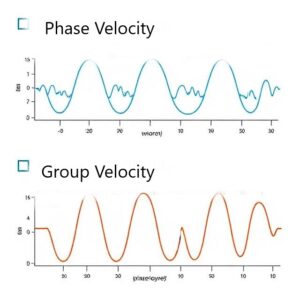1. Phase Velocity (vₚ):
Phase velocity is the speed at which a single wave crest (or a specific point on a wave) moves. It is the speed at which the pattern of the wave travels.
What does it mean?
- Imagine you’re watching a wave, like an ocean wave. The crest (the top part of the wave) moves along the water.
- Phase velocity is the speed at which that crest moves.
In terms of light or other waves, the phase velocity is how fast the individual wave’s crests (or any specific phase of the wave) move through space.

Formula for Phase Velocity:
The phase velocity
is given by:
Where:
is the wavelength (distance between two wave crests).
is the period (the time it takes for one complete wave to pass a point).
Example: For a light wave, the phase velocity is the speed of light in a medium, which is about 300,000 km/s in a vacuum.
2. Group Velocity (vₖ):
Group velocity is the speed at which a group of waves or a wave packet (which is a collection of many waves of different frequencies) travels. The group velocity is often associated with how the energy or information carried by the waves moves.
What does it mean?
- Think of a wave packet as a group of ocean waves of different sizes coming together. The group velocity is the speed at which the entire “bunch” of waves moves forward.
- If you were to send a signal with multiple different frequencies (like a radio signal), the group velocity would tell you how fast that signal travels.
Formula for Group Velocity:
The group velocity
is given by:
Where:
is the angular frequency (related to how fast the wave oscillates).
is the wave number (which is related to the wavelength).
In simple terms, the group velocity is the rate at which energy or information moves through a medium.
Example: For a pulse of light traveling through a fiber optic cable, the group velocity would tell you how fast the information or signal inside the light pulse is traveling.
Key Differences Between Group Velocity and Phase Velocity:
- Phase Velocity:
- Measures the speed of individual wave crests.
- Describes how fast a single frequency moves.
- It is important in understanding how individual waves travel.
- Group Velocity:
- Measures the speed of the wave packet or group of waves.
- Describes the speed at which energy or information moves.
- It is important for understanding how signals (or information) travel.
In Summary:
- Phase Velocity tells you how fast the individual wave crests are moving.
- Group Velocity tells you how fast a group of waves or the energy in a wave packet is moving.
- Group velocity is typically more important when we talk about signal transmission and how information moves.
Real-Life Example:
- If you are watching a wave on the ocean, the crest (the highest point) of the wave moves at a certain speed — this is related to phase velocity.
- If you are sending a message using a pulse of light or a radio signal, the group velocity would be the speed at which the signal or information moves from one place to another.
These two velocities describe different aspects of how waves behave in various situations. Understanding both is key in areas like optics, communication systems, and wave theory.
Tags: angular frequency (ω), Communication Systems, crest movement, difference between phase and group velocity, energy movement, energy transfer speed, fiber optic communication, group of waves, group velocity, individual wave behavior, information transfer, lambda (λ), medium effects on speed., multiple frequencies, Optics, phase movement, phase speed in medium, Phase velocity, pulse travel, radio signal, signal propagation, signal speed, signal transmission, single frequency motion, speed of light, time period (T), vacuum, wave crest, wave group speed, wave number (k), wave number relation, wave oscillation, wave packet, wave pattern speed, wave period, Wave theory, wavelength


